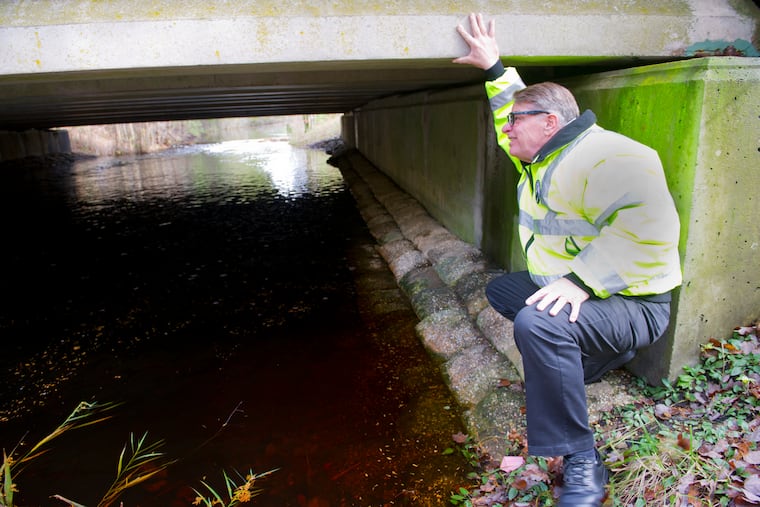Under the Atlantic City Expressway, Pine Barrens critters have their own roads
The South Jersey Transportation Authority recently announced it was installing 10 new bat boxes — wooden structures that can comfortably house up to 80 bats — with plans to add 20 screech owl nesting boxes at wooded locations along the Atlantic City Expressway's right-of-way in 2019.

Why do Pine Barrens critters cross the Atlantic City Expressway? And how do the little guys, like raccoons and snakes, get to the other side?
They walk right underneath, said Nick Marchese, a project manager at the South Jersey Transportation Authority.
The agency, which operates the expressway and the Atlantic City International Airport terminal, maintains makeshift stone pathways along water crossings in the Makepeace Wildlife Management Area at eight locations along the expressway. Creatures find their way thanks to a series of fences along the expressway. They can walk, hop, or crawl right along the water, reducing roadkill as well as the environmental impact of the 44-mile highway.
The paths, constructed in conjunction with a highway widening project that wrapped up in 2014, include camera monitoring that's tracked and maintained by the New Jersey Division of Fish and Wildlife.
"If you design them right and put them in the right places, they have proven to be really effective at enabling animals to move from habitat to habitat at either side of the road safely without them being a human hazard to people hitting them," said Gretchen Fowles, a biologist working for New Jersey Fish and Wildlife on the project.
The project enables many kinds of local wildlife, some as large as coyotes and deer, to move freely through the Pine Barrens, said Fowles.
"That's working out well," said Marchese. "We continue to evolve the program through the authority because we can, and we think it's the right thing to do. We're 28 miles in the Pinelands. We've always been very sensitive to the Pinelands."
And it's not just the walkers and slitherers. The agency is working on a handful of projects to aid native bats, owls, bees and more. It recently announced it was installing 10 new bat boxes — wooden structures that can comfortably house up to 80 bats — with plans to add 20 screech owl nesting boxes at wooded locations along the expressway's right-of-way in 2019. The agency currently has more than 120 boxes of various types to house bats, American kestrels, blue birds and more, said Marchese. They're mostly used during summer months, since birds migrate and bats prefer more insulated spots in the winter.
Students at Gloucester County Institute of Technology built the bat boxes, with help from SJTA craftsmen and materials provided by the agency. A carpenter's technology class at Camden County College will help with the screech owl boxes. Using mostly recycled materials, the boxes are inexpensive to make and can have an impact, according to experts.
"It's a great project," said MacKenzie Hall, a biologist working for Fish and Wildlife. "Bats can use all the options they can get these days."
There's been a large decline in North American bats across the East Coast, said Hall. White-nose syndrome, an emerging fungal disease, has killed more than six million bats in the United States and Canada since 2007, according to the U.S. Geological Survey.
Bats often roost in dead or dying trees, Hall said. Since those can be chopped down or fall at any time, the stability bat boxes offer is a welcome change.
"They like to keep their options open," Hall said. "If they discover one of these things near an existing roost, then they might make that part of their rotation or settle into it permanently. A lot of times they feel like a bat house on a nice, solid pole doesn't feel like it's going anywhere. A lot of times they'll just settle into it for the whole season."
There are also other benefits, said Hall. Though there's a stigma surrounding bats, they can have an impact on local insect populations. The boxes will mainly be used by a species called the big brown bat, which can consume up to 3,000 mosquito-size flying insects a night. A nursing mother bat can eat even more: up to 4,500 insects a night. These insects include cucumber beetles, leaf hoppers, termites, ants, roaches, corn ear worms, grasshoppers and mosquitoes. Multiply that times 50 to 100, and these boxes can have an impact on local pest bug populations, Hall said.
The educational benefit of the program is crucial, said Hall.
"They're a great learning opportunity for people to understand a little bit more about bats and to think, 'Maybe they are good neighbors,' rather than these spooky creatures that we're taught to distrust and be afraid of," she said. "The more people that see that as a positive, the more benefits we as a society will bring to bats in general. People putting up bat houses of their own, or deciding to manage their own land better for wildlife. Or if there's a homeowner that discovers a colony in their attic and they need to deal with that, they'll realize that bats are beneficial and they'll handle the situation properly, rather than lethally or by other means."
That's why the authority travels to local schools to discuss the importance of environmental sustainability. With their mascot Farley the Fox in tow, agency officials discuss environmental issues, as well as help plant trees for Arbor Day and set up butterfly boxes.
"Our goal is making sure: Education first," said Marchese. "We're trying to make the program contagious. We'd like to see other agencies try the same thing."